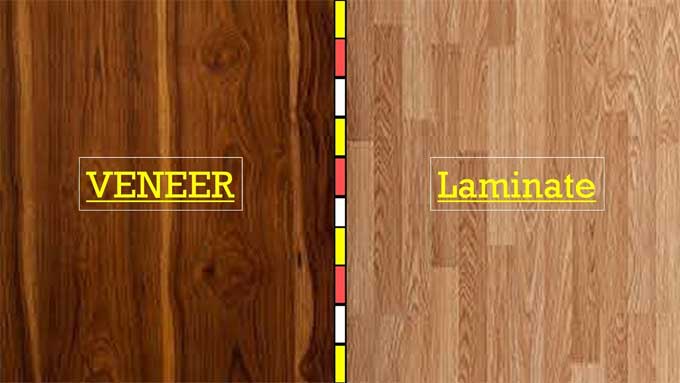
What's the Best Option for finishing your beloved home's Interior: Laminate or Veneer?

Furniture, cabinets, and floors often feature veneer and laminate as surface finishes. Under extreme pressure, layers of flat paper and plastic resins are laminated together as laminate, whereas thin slices of wood are glued to a plywood base as veneer. Furniture bases typically consist of plywood or particleboard to enhance their appearance.
Define Laminate
The durability and scratch resistance of laminates is quite good. In comparison to veneer and solid wood products, Laminates are more durable, moisture-resistant, and heat resistant. Excessive water can lead to the warping of laminated surfaces. They are also susceptible to chipping since they are brittle materials.
Define Venner
A veneer is an extremely thin piece of wood applied to the surface of particleboard or other types of manufactured wood. The use of veneers can reduce costs without sacrificing the appearance of a project. Glue, nails, or screws can attach veneers. In addition to cabinets and furniture, veneers are often used for floors. The frames and shelves are made of particleboard or plywood, and the viewable surfaces are covered with veneer.
Benefits of Using Laminate
1. The production of laminates is easy because they are produced with machines. In addition, they are readily available and have a low cost of production.
2. Unlike wood veneers, laminates do not have natural variations in the sheet, as they are preprinted. Laminates are available in endless designs.
3. They can mimic a wide variety of surfaces such as wood, stone, marble, leather, and many others due to their glossy and rough textures. Personalized prints can also be printed on the sheets.
4. Several layers of materials are compressed under high pressure to create powerfully durable and impervious laminates. Since laminates resist heat, moisture, stains, and scratches better than veneers, they tend to be harder to clean and maintain. As a result, they are ideal for high traffic and moisture areas like kitchens and tabletops. The typical laminate flooring sustains ten years.
Benefits of Using Venner
1. Each veneer sheet is unique because it derives from real wood. Solid wood surfaces possess an organic look unique to solid wood surfaces that are matched only by embedded natural patterns.
2. The appearance of veneer sheets can be tailored to the intended hue and grain of a particular design theme, just like solid wood.
3. Since the strength of veneers and their appearance are largely determined by the designer, a quality installation will last longer and hold up stronger. Unless improperly installed and maintained, veneers should last at least 15 years.
4. Solid wood applications can be economically replaced with veneers because veneers are a renewable resource. The number of veneered wood slices that can be made from a log of timber increases its cost-effectiveness. In addition to that, inexpensive wood boards or plywood boards can also be backed by pricey veneer sheets to give them a rich look within a budget.
Drawbacks of Laminate
1. The printed decorative layer is usually covered with a thin layer of transparent plastic. The finished surface cannot be sanded, stained, or textured as needed to meet design requirements.
2. Plastics and resins make up laminate sheets. Certain resins emit dangerous gases.
3. The polishing material seals the corners and seams of veneer installations. Laminate applications, however, have open and sharp edges.
4. Due to poor design, hard laminate sheets are often clipped and broken, which can only be fixed by replacing the worn sheet with a new one.
Drawbacks of Venner
1. In comparison to laminate sheets, a veneer is softer. During the aging process, the polish layer of a veneer wears off, making it vulnerable to abrasions.
2. Moisture can cause the veneer sheet to bubble or warp if the top layer exposes to heat or moisture penetrates the core material. So, they are not the best choice for wet areas like kitchens and bathrooms.
3. Installing Venner Sheets or slicing it requires a professional carpenter. As a result, compared to laminate, these procedures are more costly. Moreover, some veneers are incredibly expensive.
To learn more, watch the following video tutorial.
Video Source: Engineering Motive
4. Veneers must be polished to maintain their luster. Spraying or painting is required to restore color or texture to polish materials. The surface can be sanded and repainted depending on the thickness of the polish applied to cover warps or tears.


